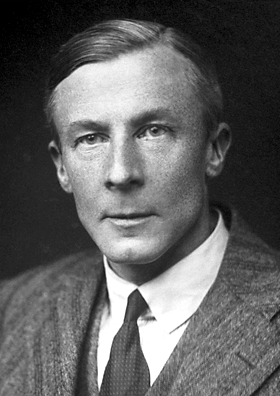Edgar Adrian, 1st Baron Adrian facts for kids
Quick facts for kids
Edgar Douglas Adrian
|
|
|---|---|

Edgar Douglas Adrian
|
|
| Born | 30 November 1889 |
| Died | 8 August 1977 |
| Alma mater | University of Cambridge |
| Awards | Nobel Prize in Physiology or Medicine (1932) |
Edgar Douglas Adrian was a famous English doctor and scientist. He was born on November 30, 1889, in London, England. He became known for his important work on how our nerves send messages.
In 1932, he won the Nobel Prize in Physiology or Medicine. He shared this big award with another scientist, Charles Scott Sherrington. They won for their discoveries about how neurons work. Neurons are the tiny cells that make up our nervous system.
Contents
Who Was Edgar Adrian?
Edgar Douglas Adrian was a brilliant scientist. He spent his life studying the human body, especially the brain and nerves. His research helped us understand how we feel, move, and think.
He was also known as the 1st Baron Adrian. This is a special title given to important people in England. He was a member of the Order of Merit and the Royal Society.
Early Life and Education
Edgar Adrian grew up in London. He was a very smart student from a young age. He went to Westminster School, which is a famous school in London.
Later, he studied at the University of Cambridge. This is one of the oldest and most respected universities in the world. He focused on medicine and the science of how living things work, called physiology.
Understanding Nerve Signals
Adrian's most important work was about nerve cells, or neurons. He studied how these cells send electrical signals. These signals are how our brain talks to the rest of our body. For example, when you touch something hot, nerve signals quickly tell your brain it's hot.
He found out that nerve cells send "all-or-nothing" signals. This means a nerve cell either sends a full signal or no signal at all. It's like a light switch that is either on or off, not dim. He also discovered that the strength of a feeling, like pain, depends on how many nerve cells send signals and how often they fire.
Adrian used special tools to measure these tiny electrical signals. His experiments helped us see and hear the activity of single nerve fibers for the first time. This was a huge step forward in understanding the nervous system.
The Nobel Prize
In 1932, Edgar Adrian received the Nobel Prize. This is one of the highest awards a scientist can get. He shared it with Charles Scott Sherrington. Their work together changed how we think about the brain and nerves.
Their discoveries laid the foundation for much of what we know about neuroscience today. Neuroscience is the study of the nervous system. Thanks to them, we understand better how our senses work, how muscles move, and how our brain processes information.
A Lasting Impact
Edgar Adrian continued his research and teaching for many years. He became a professor at the University of Cambridge. He also served as the President of the Royal Society, a very important scientific group.
His work helped many other scientists. It led to new ways of treating nerve problems and understanding brain diseases. He passed away on August 8, 1977, at the age of 87. His discoveries still help doctors and scientists today.
See also
 In Spanish: Edgar Douglas Adrian para niños
In Spanish: Edgar Douglas Adrian para niños

